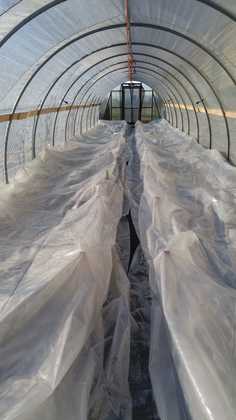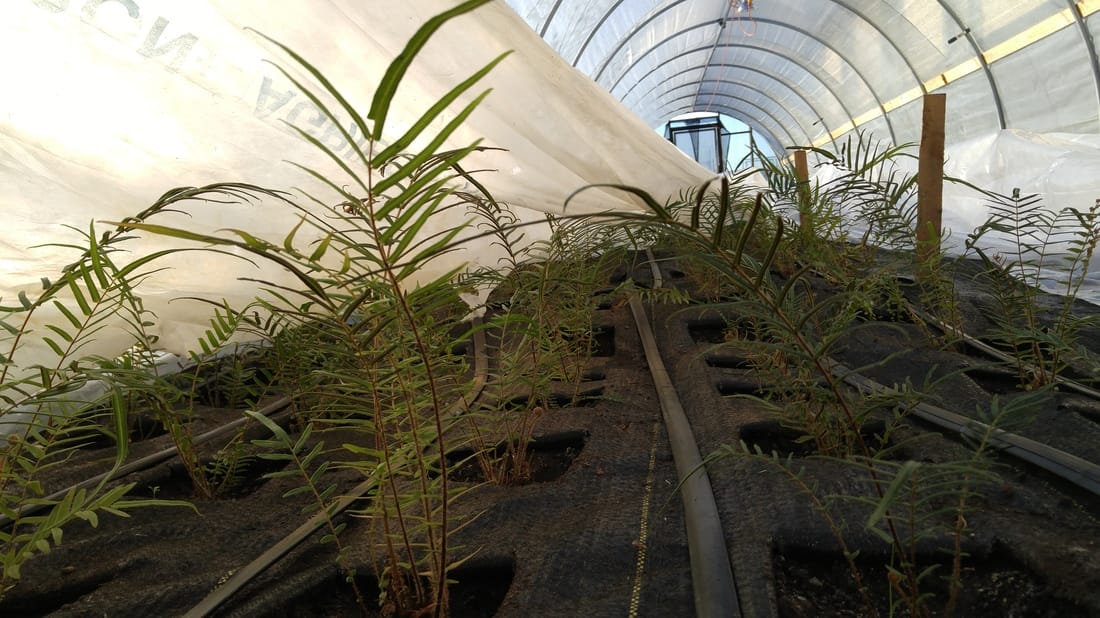 Can't see the ferns for the plastic! Ferns in the hoop house we built at our Richmond Field Station field site, Richmond, CA. Ferns are under 6 mil plastic and floating row cover, for freeze protection. Can't see the ferns for the plastic! Ferns in the hoop house we built at our Richmond Field Station field site, Richmond, CA. Ferns are under 6 mil plastic and floating row cover, for freeze protection. The weather in the San Francisco Bay Area has been cold for our humid subtropical hero, the brake fern, Pteris vittata. Here in our Mediterranean clime lows have been in the mid 30’s with freeze and frost warnings. Previous experience lets me know that frost and freezing temps do not mix well with P. vittata fern fronds. My first year, temperatures at our Berkeley field site dipped down to -3.3 degrees C (26 degrees F), and due to the cold coupled with flooding we lost 30% of our ferns over the winter. The ferns we recently planted out at our Richmond field site are particularly vulnerable to freeze damage: they have a flush of new growth, which is tender and not acclimated to the cold. We are flirting with danger as we encourage this growth. If there is enough growth over winter and spring, we can harvest fronds in May, before the June flush of growth we normally see. The more fronds of this arsenic hyperaccumulator that we harvest, the more arsenic we remove from the soil. The ferns in our field studies are planted in a hoop house, also known as a high tunnel, a common season extension structure that is basically an unheated, temporary greenhouse erected in a field. The hoop house protects from wind and can provide a few degrees of frost/freeze protection. Hoop houses are especially advantageous during advective freezes, which are freezing events brought about during windy weather by movement of cold air. But on calm nights, radiation freezes can occur, where the ground cools and loses heat to the air above it. The cool air settles at the ground with warmer air above it, which is called an inversion. Closed up hoop houses are not particularly helpful in this situation, because a closed hoop house prevents the cooler air at ground level from mixing with the warmer air above the surface. Commercial growers often use fans on calm, clear nights, especially in orchards, to prevent radiation freeze damage to budding trees. It’s also important to cover sensitive plants on cold nights to keep the plants from freezing. Covering plants at night takes advantage of the heat stored in the soil. Soil is a sink for heat during the day, and a source at night, as the heat is slowly released. The covers keep this heat close to plants, providing them with a few degrees of protection. I use floating row cover for lightweight protection, and then add 6 mil plastic on top when I want more protection. Floating row cover has the advantage of being lightweight and allowing air movement, so it can be left on for multiple days. However, cold can wick through covering material that is directly touching plant leaves, so be prepared for minor amounts of damage if frost occurs. Water is another secret weapon in the struggle to keep plants alive on cold nights. Water provides excellent heat storage, as it has a very high specific heat capacity – it takes a lot of heat (calories) to raise the temperature of water 1 degree C. The specific heat capacity of water is higher than that of soil, and much higher than that of air, so the amount of heat released from wet soil as the soil temperature falls 1 degree C is enough to raise the air temperature several degrees. Not only does wet soil store more heat than dry soil, it also conducts more heat than dry soil, so that heat is effectively transferred from warmer areas to cooler areas, moderating the soil temperature overall. Likewise, humid air stores more heat than dry air. Furthermore, as water cools, it releases heat to the surrounding air. I noticed the overnight air temperature in the hoop house was dropping to its minimum early mornings between 4:45 am and 7:15 am, a lag period again due to the slow release of heat from the earth’s surface. So, when the overnight low was around 0 degrees C (32 degrees F), I kept the soil moist during the day (to better absorb heat) and set the irrigation to come on at 4:00 am, so the irrigation water would provide some additional heat during those crucial few hours before sunrise. While water is a great way to moderate temperatures, constantly damp soil can promote the growth of fungal diseases, and limit plant growth due to low oxygen concentrations. It's important to use water to your advantage, and then let the soil dry to field capacity when possible. And one final secret weapon, if you have access to electricity: incandescent lighting! Rope lights under covering material are not only festive - they are a great, water-proof way to provide just a little heat at soil level, enough once again to keep sensitive plants from freezing. I haven’t pulled this one out yet, but we’ll see what the first few days of 2017 bring…! I'm always on tenterhooks approaching a hoop house the morning after a cold night. What will I find under the layers of plastic and agribon? I step into the warm, humid hoop house, close the door tight behind me, and pull back the covering with trepidation. It's such a relief to see living plants with no frost or freeze damage! I pull back the plastic and floating row cover, and free the plants to soak up the sun's energy in their protected microclimate.
0 Comments
Leave a Reply. |
AuthorSarick Matzen completed his PhD in Environmental Science, Policy, and Management department at University of California, Berkeley in 2020. He is now a postdoc in the Soil, Water, and Climate Department at the University of Minnesota working on iron cycling in marine systems. Archives
July 2019
Categories |

 RSS Feed
RSS Feed
